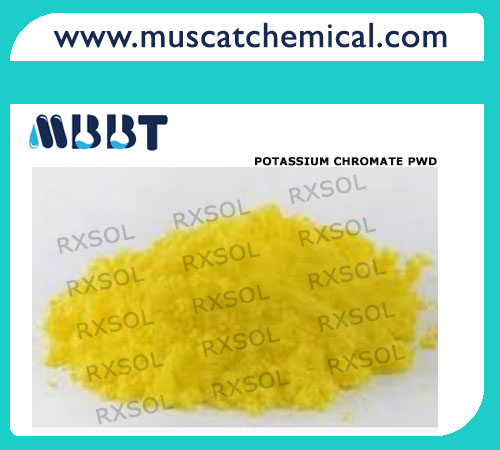
K2CrO4, Potassium Chromate
Potassium Chromate supreme supplier, manufacturers and exporters. Potassium Chromate is a yellowish, crystalline, inorganic compound that emits toxic chromium fumes upon heating. Potassium chromate is highly corrosive and is a strong oxidizing agent.
|
Assay |
: |
Min.99.5 % |
|
pH ( 20' c; 5 %) |
: |
8.6 to 9.8 |
|
Insolubility in water |
: |
Max. 50 ppm |
|
CI (CHLORIDE) |
: |
Max. 10 ppm |
|
SO4 (sulphate) |
: |
Max. 100 ppm |
|
Ca ( Calcium) |
: |
Max. 50 ppm |
|
Cu ( Copper ) |
: |
Max 10 ppm |
|
Fe ( Iron) |
: |
Max. 15 ppm |
|
Na ( sodium ) |
: |
Max 0.03% |
|
Pb ( Lead) |
: |
Max 50 ppm |
Potassium chromate is a yellow crystalline solid. It is soluble in water. The primary hazard is a threat to the environment. Immediate steps should be taken to limit its spread to the environment.
Potassium chromate primarily affects the nose, throat and lungs causing ulcerations, shortness of breath, bronchitis, pneumonia and asthma but can also affect the gastrointestinal tract, liver, kidneys and immune system. This substance is a known human carcinogen and is associated with an increased risk of developing lung cancer and cancer of the sinonasal cavity.
| Physical State | Solid |
| Appearance | yellow |
| Odor | odorless |
| pH | 8.6-9.8 (5% soln) |
| Vapor Pressure | 0 |
| Vapor Density | Not applicable |
| Evaporation Rate | Not applicable |
| Viscosity | Not applicable |
| Boiling Point | Not available |
| Freezing/Melting Point | 975 deg C |
| Autoignition Temperature | None reported |
| Flash Point | Not available |
| Decomposition Temperature | Not available |
| NFPA Rating |
(estimated) Health: 2; Flammability: 0; Reactivity: 0 |
| Explosion Limits, Lower | None reported |
| Upper | None reported |
| Solubility | Soluble |
| Specific Gravity/Density | 2.7320 |
| Molecular Formula | K2CrO4 |
| Molecular Weight | 194.20 |
Yellow crystals, soluble in water.
Hazard: Toxic By ingestion and inhalation.
Used: Reagent in analytical chemistry, aniline black, chromate pigments.
|
|
|
| Chemical Formula | K2CrO4 |
| Formula Weight | 194.19 |
| CAS No. |
7789-00-6 |
Potassium Chromate is used in the qualitative inorganic analysis to detect the ions in aqueous solution. Potassium chromate is used in the manufacture of dyes. Potassium chromate is used in precipitation titrations as an indicator. Potassium chromate is used in the textile dyeing process. Potassium chromate is used in making inks and pigments for paints. Potassium chromate is used as a fungicide. Potassium chromate is used to make several other chromium compounds. It is used in the leaching process.
Potassium Chromate is used as an indicator in the determination of Chloride by titration with standard Silver Nitrate solution. This method is called the Mohr method of determining Chloride and is based on the formation of a red precipitate of Silver Chromate at the endpoint after all of the Chloride has been precipitated as white Silver Chloride. A 5% solution of Potassium Chromate that has been Chloride neutralized (Group No. 6000) is commonly used. Approximately 1 mL of this indicator should be used per 100 mL of sample volume.
The accuracy of the Mohr method decreases as the Silver Nitrate concentration decreases due to the amount of excess Silver Nitrate that must be added to produce enough Silver Chromate to be seen visually. The Mohr method must also be performed in the pH range of 6.5 to 9. If the pH is too high, brownish Silver Hydroxide forms and masks the endpoint. If the pH is too low, the Chromate is converted to Dichromate and the endpoint comes too late or can not be perceived at all. In the presence of Ammonium ions, the pH must be kept below 7.2 to prevent partial conversion of the precipitate to soluble Ammine complexes.
For comparison purposes, all Mohr titrations should be carried out at about the same temperature, since the solubilities of Silver Chloride and Silver Chromate depend on temperature. Good stirring during the addition of the Silver Nitrate is also required; otherwise, Silver Chromate that forms locally before the endpoint can become occluded in the Silver Chloride precipitate instead of redissolving. Poor agitation could lead to an endpoint that is neither sharp nor reproducible. The reactions for the Mohr titration are:




